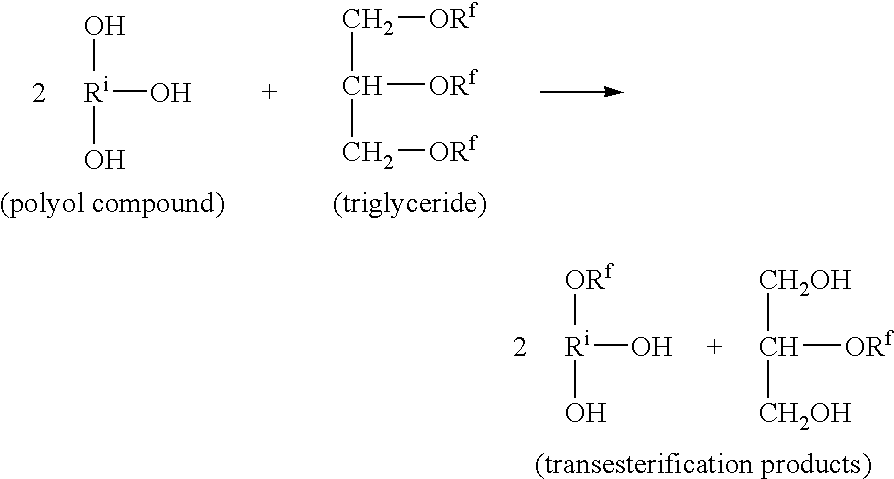Process for preparing functionalized oils; adhesives and coatings and interpenetrating polymer networks prepared from the functionalized oils
- Summary
- Abstract
- Description
- Claims
- Application Information
AI Technical Summary
Benefits of technology
Problems solved by technology
Method used
Image
Examples
example 1
[0080]Chinese tung oil (82.1 g, ˜0.088 moles), trimethylolpropane (TMP) (23.6 g, ˜0.193 moles) and 0.49 g of a calcium naphthenate catalyst containing about 5% calcium (CEM-ALL, by OMG Americas, Inc.) are charged into a reaction kettle equipped with stirrer, thermometer, nitrogen inlet, condenser and heat jacket. The catalyst concentration is about 0.03%, based on 100% calcium naphthenate. The mixture is heated to about 200° C. under nitrogen. When the reaction temperature reaches 70° C., an opaque homogeneous liquid mixture is formed with a light color and low viscosity. As the temperature reaches about 150° C., the liquid mixture becomes translucent with a light color. When the mixture is heated at 190-200° C. for about 15-20 minutes it becomes transparent and lightly colored. However, it becomes translucent again after cooling, indicating that the transesterification reaction has not been completed. After heating an additional 20-30 minutes at about 200° C., the liquid becomes tr...
example 2
[0081]Example 1 is repeated, except that the calcium naphthenate catalyst is replaced with calcium chloride. Calcium chloride is a solid, which allows for it to be removed easily from the product by filtering or centrifuging. Removing the catalyst has advantages in some applications where residual catalysts may interfere with other additives (such as, for example melamine-urea resins which engage in acid-catalyzed reactions). The reaction proceeds more slowly at about 200° C. than the calcium naphthenate-catalyzed reaction of Example 1. The more prolonged exposure to heat causes the functionalized oil product to become slightly darker and more viscous than the product of Example 1. The functionalized product reacts with polyisocyanates at room temperature similarly to the product of Example 1.
example 3
[0082]Example 1 is repeated again, except that the calcium naphthenate catalyst is replaced with another solid catalyst, zinc chloride. The reaction proceeds more slowly at about 200° C. than the calcium naphthenate-catalyzed reaction of Example 1, again causing a slightly darker and more viscous product to be formed. The functionalized product reacts with polyisocyanates at room temperature similarly to the product of Example 1.
PUM
| Property | Measurement | Unit |
|---|---|---|
| Temperature | aaaaa | aaaaa |
| Percent by mass | aaaaa | aaaaa |
| Percent by mass | aaaaa | aaaaa |
Abstract
Description
Claims
Application Information
 Login to View More
Login to View More - R&D
- Intellectual Property
- Life Sciences
- Materials
- Tech Scout
- Unparalleled Data Quality
- Higher Quality Content
- 60% Fewer Hallucinations
Browse by: Latest US Patents, China's latest patents, Technical Efficacy Thesaurus, Application Domain, Technology Topic, Popular Technical Reports.
© 2025 PatSnap. All rights reserved.Legal|Privacy policy|Modern Slavery Act Transparency Statement|Sitemap|About US| Contact US: help@patsnap.com

